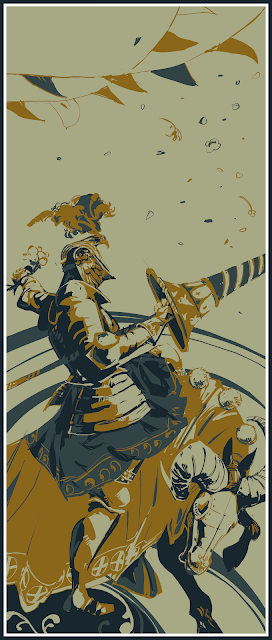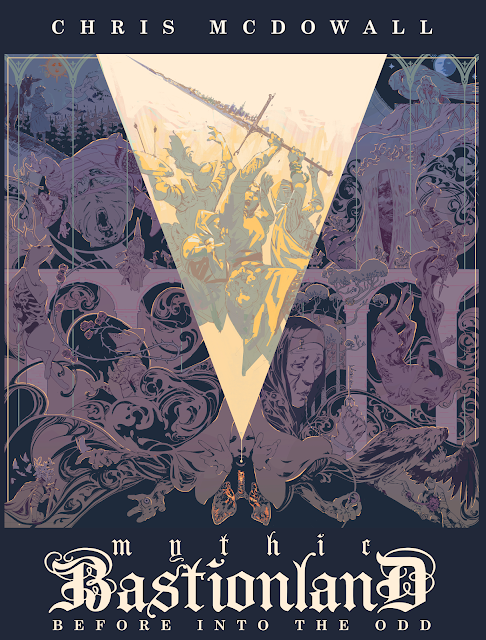First of all, go and follow Mythic Bastionland on Kickstarter
Okay, onto the post.
What use is an RPG if it doesn't have a giant list of weapons and armour?
After all, this was one of my favourite pages of my first D&D book.
Not to mention this beauty.
In the process of writing Mythic Bastionland I've
done a bit of deep-diving into medieval weapons and armour, so the red flags in
those pieces leap out at me now.
Still, I remember loving those spreads because somehow the
art makes it all feel very real.
But what does it matter? That's for D&D, a fantasy game,
so who cares if the weapons favour style over historicity or practicality?
Mythic Bastionland is also overtly Myth not History.
I have that phrase written at the bottom of my notes doc for this game. So why
have I been spending so much time thinking about authenticity?
Let's break this down into weapons and armour.

Weapons in Mythic Bastionland largely follow
on from Into the Odd and Electric Bastionland. You've got single
handed weapons that do d6 or d8 damage, then two-handed weapons that do d8 or
d10, though the larger die types are a little easier to get hold of in this
setting. Swords get special treatment, rolling multiple dice, which in this
system results in you keeping the single highest result, so they're more
reliable and have some extra benefits when you dig into the Feat and Gambit
systems.
Bulky is gone. Since you're all Knights with, at the very
least, a steed, it's easier to justify extra load. You might have a Squire to
carry even more stuff, so let's just not bother tracking it at all.
There's also much less focus on hauling treasure back from
dungeons, so fewer interesting decisions to be had about what stuff you leave
behind.
Instead, the interesting decisions around weapons in this
game are:
- What
do I use in each hand? Two-hander? Dual weapons? Weapon and shield? It's
not super complex but there are definitely times you might consider
switching up for a particular situation.
- If
my weapon does something fancy, like the Talon Knight's hookhammer (bonus
when leaping down onto the enemy), how do I set that up?
- Am I
going to be fighting somewhere that makes certain weapons especially
appealing or awkward to use?
Now that last one not have lots of rules support in the
game. There's a mention that long weapons are impaired in tight spaces, and
you've got things like skeletons being resistant to piercing attacks, but
looking at the weapon list there's zero difference between a Spear (d8 hefty)
and Axe (d8 hefty).
Except that Spear is obviously going to be longer than the
axe, so you can probably use it to fight over a barricade, or from behind an
ally.
And of course the Axe is better at breaking down doors.
Obviously the spear is no good for that.
So the book doesn't present rules for these things because
you already know those rules. I suspect this might rub some readers the
wrong way, but I do hope that in most at-the-table situations these things just
sort of... work naturally.
In terms of building a weapons list that's appropriate to
the implied era of Mythic Bastionland, I'm clearly drawing on the
medieval period.
But which bit of it? Early-medieval makes sense as the
setting for Arthurian Myth.
So javelins and bows rather than longbows and crossbows.
Spears and axes rather than swords and halberds.
Except... Arthurian myths very often take a more generous
approach when it comes to equipment. Most images of a Knight are drawing on
late-medieval or even early-Renaissance stuff. So we throw those fancy weapons
back in, but just make them rare. Only very few of the Knights actually
start with a sword. That guard can have a halberd though, it just looks
right.
So as with so many before me, I'm walking a tightrope of
wanting some of that historical feel while also wanting that mythic
freedom to pull in things that feel right stylistically, if not
realistically. The focus on rarity rather than cost should help with this, as
owning a sword isn't about getting enough money. There isn't even a price
listed for each weapon. Instead, you've got to actually find somebody who wants
to sell one or can make you one from scratch. At this point you might as well
just kill another Knight and take theirs, perhaps grab their Holding while
you're at it.
That still counts as Protecting the Realm, right? I
mean it's probably safer under my watch.

Armour also follows the same baseline of the previous
games in the series. Armour gives you a point of armour, a shield gives you
another.
Except now I've added helms and plates (extra armour worn to
battle) as two other ways to grab armour points, giving a fully armoured Knight
Armour 4, something unfathomable in Into the Odd.
Part of this is balanced out by the general increase in
damage output, but that's not really the whole point. Again it comes down to
creating interesting choices.
Let's say you own the full set of armour: coat, plates,
helm, shield. You aren't just walking around suited-up all day every day. The
general assumption is that helms and plates are removed when you're travelling
or socialising, and we all know that shields can be shattered.
Here armour is less about permanently etching the highest
number you can onto your character sheet, and more about considering the
situational nature of your protective gear.
If you really want to kill a Knight then facing them in an
open battle means you're facing the full wall of steel. Why not just come at
them with daggers when they're out riding in just their gambeson? Or invite
them into your home and kill them there... wait, what sort of game is this
again?
Again, I want gear in this game to feel more nuanced than
"when can I buy that fancy gear", instead looking at the actual
decisions somebody would need to make about their equipment.
As a side note, I do get a small pleasure from including
layers of armour here. Coats represent flexible protection that you can
generally wear all day (mail, gambeson) while Plates are the hard stuff layered
on top for battle (plate, brigandine, splint). Then you've got the
self-explanatory helms and shields. There's definitely a sort of paper-doll
appeal where I can visualise very clearly how a character looks different based
on which combination of their armour they're currently equipped with, slotting
the paper armour on top of their outline. I think today... the hauberk under
the brigandine, the great helm on top.
I guess I'm just not used to the novelty of considering what
an individual character looks like in various grades of protection. In so many
games it can feel like they're welded inside their harness of choice.
While I'm not looking to provide an accurate simulation of
the weapons and armour of a particular period of history, I want the players to
look at their gear and interact with it in a way that makes it feel real.
Even if it's all just a myth.
----------------------------------------------------------------------------
This post was originally sent as a reward to all Patreon supporters, and is released freely on this site the week after its original publication.
If you want to support my blog, podcasts, and video content then head over to my Patreon.










